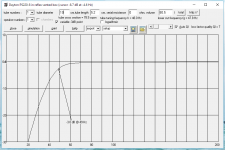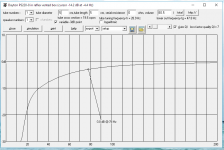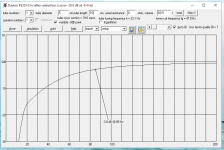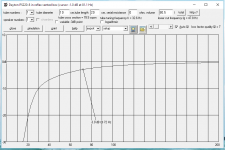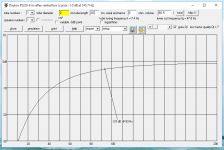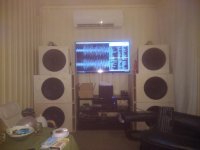Again everybody from around the globe big thanks for the insights. This weekend im gonna design soome more stuff and keep you posted here. Wish you a great weekend!
Now on to the contents:
My speaker dimensions will be wider than deep, say 40cm wide face, 20 cm deep, and 100cm tall floorstanding, 2cm thick real wood, for a volume of 80L vented design. I asked what if I would place the port opening on the bottom, 5 cm above ground, but nobody has answered that question yet 😉
@KaffiMann, so what are you suggesting? That sealed boxes are the ones with "fewer to little problems"?
@ICG, thanks for your clarification mate! Very appreciated. From your legend I have conducted some moore experiments that yielded the following variations:
Hereafter the first numer represents the tube diameter, the second number the tube length.
10 - 5.2 the default advised by the program specifically for the Dayton Audio PS229-8
(Notice the resistance in series was default chosen by the porogramm to be 0. Is that correct?)
In addition to the default, I'm adding the following variatons:
5 - 5
5 - 10
10 - 20
2 - 20
Just looking at the graphs the 2 - 20 option looks the "smoothest".
Is that what we are looking for? Can this be a cheap PVC tube 2 cm diameter, 20 cm length?
Now on to the contents:
My speaker dimensions will be wider than deep, say 40cm wide face, 20 cm deep, and 100cm tall floorstanding, 2cm thick real wood, for a volume of 80L vented design. I asked what if I would place the port opening on the bottom, 5 cm above ground, but nobody has answered that question yet 😉

@KaffiMann, so what are you suggesting? That sealed boxes are the ones with "fewer to little problems"?
@ICG, thanks for your clarification mate! Very appreciated. From your legend I have conducted some moore experiments that yielded the following variations:
Hereafter the first numer represents the tube diameter, the second number the tube length.
10 - 5.2 the default advised by the program specifically for the Dayton Audio PS229-8
(Notice the resistance in series was default chosen by the porogramm to be 0. Is that correct?)
In addition to the default, I'm adding the following variatons:
5 - 5
5 - 10
10 - 20
2 - 20
Just looking at the graphs the 2 - 20 option looks the "smoothest".
Is that what we are looking for? Can this be a cheap PVC tube 2 cm diameter, 20 cm length?
Attachments
Now on to the contents:
My speaker dimensions will be wider than deep, say 40cm wide face, 20 cm deep
Try to avoid multiples of the same dimension if you can, as they promote internal eigenmodes (standing waves).
...and 100cm tall floorstanding
You may need to use some internal panels / bracing to break up the longitudinal standing wave, or it will alter your box alignment away from what you are expecting.
2cm thick real wood
So long as it's properly selected, tight grain, fully dried & sealed to prevent movement, a decent choice
, for a volume of 80L vented design.
Technically you will need a little more to account for the volume taken up by internal bracing (which you really do need in a box this size), the vent and the driver itself. A little leeway is OK as small differences will be swamped by room characteristics, driver production tolerance variations etc. But give it, say, another couple of litres.
I asked what if I would place the port opening on the bottom, 5 cm above ground, but nobody has answered that question yet
What exactly are you asking? Down-firing vents are fine; arguably they have some advantages in terms of tuning flexibility to forward or rear firing as you can adjust the damping by means of the gap to the floor. If you want maximum output, you'll need a hard surface rather than an absorbative one below it, obviously.
@KaffiMann, so what are you suggesting? That sealed boxes are the ones with "fewer to little problems"?
Bluntly, he's spouting the kind of fundamentalism that is the bane of many designer's lives, taking a single aspect of operating physics and elevating it to the point where he's essentially pronouncing that every vented loudspeaker is fundamentally poor on that basis alone. Which is not true. While his point is partially valid and vented boxes have more in the way of phase shift than some other types of enclosure, this is not automatically the horrific thing for performance he's trying to make it out to be. We all of us make a selection of engineering compromises, and for most people, a well implemented vented enclosure is extremely effective and the issue he is making such a song & dance over is a sacrifice made to obtain more useful advantages elsewhere.
Hereafter the first numer represents the tube diameter, the second number the tube length.
10 - 5.2 the default advised by the program specifically for the Dayton Audio PS229-8
(Notice the resistance in series was default chosen by the porogramm to be 0. Is that correct?)
Technically no since even if you have a very low output impedance amplifier (which you imply you have) your speaker wire and connections have some resistance. In most cases it's probably in the order of about 0.5ohms. Near enough though -again, this tends to get swamped by other factors.
[/B]Just looking at the graphs the 2 - 20 option looks the "smoothest".
Is that what we are looking for? Can this be a cheap PVC tube 2 cm diameter, 20 cm length?
I don't know quite where the numbers are coming from, but they're a bit of a shotgun. 20mm diameter x just the 20mm thickness of the build material would tune an 80 litre box to about 18Hz. Put it in a crucible, say 80 litres tuned to 42Hz - 45Hz. I'd go with, say, a 50mm diameter duct x 35mm length. That'll tune it to the target region & also keep the vent air velocity low, reducing the potential for noise.
Last edited:
Hah!
I like you Scott.
I've hated bass reflex for much of my life, now the tables have turned. To refer to a specific example: the sim I posted earlier in this thread. It is easy to neglect and simplify, it is difficult to take into account and simplify.
Edit:
I am sitting and enjoying my 2way fast/waw setup right now, with Bass Reflex. Sounds better than any OB setup I've heard.
Apologies for the image quality, I had to tape my lens...
I like you Scott.
I've hated bass reflex for much of my life, now the tables have turned. To refer to a specific example: the sim I posted earlier in this thread. It is easy to neglect and simplify, it is difficult to take into account and simplify.
Edit:
I am sitting and enjoying my 2way fast/waw setup right now, with Bass Reflex. Sounds better than any OB setup I've heard.
Apologies for the image quality, I had to tape my lens...
Attachments
Last edited:
My speaker dimensions will be wider than deep, say 40cm wide face, 20 cm deep, and 100cm tall floorstanding, 2cm thick real wood, for a volume of 80L vented design. I asked what if I would place the port opening on the bottom, 5 cm above ground, but nobody has answered that question yet 😉
I would not place it that close to the floor.
@ICG, thanks for your clarification mate! Very appreciated. From your legend I have conducted some moore experiments that yielded the following variations:
Hereafter the first numer represents the tube diameter, the second number the tube length.
10 - 5.2 the default advised by the program specifically for the Dayton Audio PS229-8
(Notice the resistance in series was default chosen by the porogramm to be 0. Is that correct?)
In addition to the default, I'm adding the following variatons:
5 - 5
5 - 10
10 - 20
2 - 20
Just looking at the graphs the 2 - 20 option looks the "smoothest".
Is that what we are looking for? Can this be a cheap PVC tube 2 cm diameter, 20 cm length?
2cm diameter is WAY too small! You'll get compression and chuffing, even at medium levels, that's something you'd absolutely want to avoid.
A very deep tuning can work but often it not a good solution. The port works parasitic, that means, it takes energy 'away' from the membrane and therefore reduces the excursion, the energy is radiated by the port. The problem is, that only works around the port frequency. What limits the dynamics is the excursion further up in the bass and it becomes limited because of two things:
a. The maximum linear excursion.
b. The intermodulation distortion (IMD).
On a BB driver b. is very critical, the driver has to reproduce not only the bass, it has also to play the mid and high range, that will be distorted by the excursion. A less deep tuning reduces the excursion and the usable maximum dynamic is much better. As already mentioned, the very low tuning will reduce the excursion on the very low end but you'll get too much excursion above, in the middle to upper bass. The IMD is likely unbearable before the maximum excursion is reached on the Dayton.
I would suggest you build a test enclosure out of cheap material, OSB or particle board. Take a router and a jigsaw and make a hole for a drain pipe, these are very cheap, you can swap them out or plug 2 into each other to extend them. Listen to it and while the very deep bass might be tempting, you'll notice a less deep bass sounds often a lot crisper and dynamic.
I strongly suggest you don't go below 30Hz tuning frequency, better higher -
at least not with this BB driver.
Last edited:
I still wish you would take things other than tuning frequency of port in relation to box volume into account.
You seem to encourage flailing blindly about, until you by some insane stroke of luck happen to stumble upon something that seems to work reasonably well.
Not accurate enough.
Bass reflex can be much better than that.
Your points regarding excursion and IMD I have no argument against, but then again they are valid for absolutely every single type of design in existance.
You seem to encourage flailing blindly about, until you by some insane stroke of luck happen to stumble upon something that seems to work reasonably well.
Not accurate enough.
Bass reflex can be much better than that.
Your points regarding excursion and IMD I have no argument against, but then again they are valid for absolutely every single type of design in existance.
Last edited:
I still wish you would take things other than tuning frequency of port in relation to box volume into account.
You seem to encourage flailing blindly about, until you by some insane stroke of luck happen to stumble upon something that seems to work reasonably well.
I do not. I do encourage experimenting with simulation and I already gave direction on what to do and what not. Only playing with the values gives you an impression what does what, get a grasp on the useful range and the trade offs. Or in other words: You mistake making experience with blindly running into knifes. These experiments prevent you from building something doomed to fail.
Not accurate enough.
Bass reflex can be much better than that.
Bass reflex isn't a 'one possible result only' principle. It pretty much depends on what you use and what's the desired result. On some drivers you have a small margin of error, with others you have a vast range of good, usable possibilities.
Your points regarding excursion and IMD I have no argument against, but then again they are valid for absolutely every single type of design in existance.
That's not true. On woofers or even subwoofers IMD is pretty much a non-issue. Why are you saying something like that? Is that malice, ignorance or black and white thinking? I prefer to think it's the latter but the world isn't just black and white, especally in the audio sector there are a lot of grey shades, there is hardly anything without compromises and if you got your ideal image of a perfect speaker then someone else got probably completely different preferences and priorities.
... I thought this was the Fullrange forum? Who's talking about subwoofers?
Your posts #16 and #24 here in this thread was quite good, and OP got quite a few very good tips up to that point from everyone involved. I may have contributed to some "harsh" wording/sentence building, but it was from being disappointed, I may have had too high expectations.
OP is asking for something that will sound as good or possibly better than an 80 liter sealed box, because of his friends making generalisations. The direction he's being pointed towards right now is a really long way off into the wilderness until after years of making boxes and frustration he ends up somewhere near the starting point.
Everything he really needs is up to and including your post #24.
The best tip is from Scott: "As for you wanting frequency graphs -why not use one of the many free programmes out there and look for yourself? You'll learn more."
I posted a sim for hornresp that takes into account a multitude of things, albeit a bit rushed because I was (again) pressed for time, but really wanted to give an example of a possible solution.
Not long after you mention an alternative to winisd, which I thought was quite refreshing. However, this same program does not seem to include much else than basic frequency graphs, and those do not tell more than perhaps 30% of the story. I admit to not having intimite knowledge about Basscad, but failed to find some of the other very relevant graphs that I personally like to see after looking around the software for a bit. It does seem a bit "Simplified" which is fine by me, but may not give the OP what he is striving for, because the software does not take into account all the things relevant for a successful design encompassing one single driver. The program is NOT showing which disturbances in the frequency spectrum the bass reflex port and box dimensions can cause, this is very relevant.
Again, I apologize for any harsh wording in my posts, I can get a bit excited and ackowledge that, but it was my intention to provide what I sincerely mean is relevant correction for people striving to achieve a successful first build. If you think I have, as Scott so eloquently put it, been "spouting the kind of fundamentalism that is the bane of many designer's lives" that is perfectly fine, and everyone are entitled to having opinions. But like I wrote in my previous post: Bass reflex can be much better than that.
I am not against any specific design, and I am no expert at anything specific, I have tried both successfully and failed epicly on simulating and building Loudspeakers of many different types; Sealed, Back loaded horn, bass reflex, tapped horn, T-TQWT, voigt type solutions, and other things I can not remember the names of right now. And I am just saying: it is easier to do good on your first build if you consider several sides of the equation, before purchasing a lot of tools and material.
There is no Black and white, black does not exist, and white is every colour there is, colour is just the remainder of the light that originally hit the object. One can actually argue that the colour being reflected from an object is the colour of the light remaining after the rest of the light was absorbed by the objects surface, so the object is actually every other colour than the one you are actually seeing, but this is nitpicking, and I digress.
Please keep enjoying your speakers.
I will keep enjoying mine.
Your posts #16 and #24 here in this thread was quite good, and OP got quite a few very good tips up to that point from everyone involved. I may have contributed to some "harsh" wording/sentence building, but it was from being disappointed, I may have had too high expectations.
OP is asking for something that will sound as good or possibly better than an 80 liter sealed box, because of his friends making generalisations. The direction he's being pointed towards right now is a really long way off into the wilderness until after years of making boxes and frustration he ends up somewhere near the starting point.
Everything he really needs is up to and including your post #24.
The best tip is from Scott: "As for you wanting frequency graphs -why not use one of the many free programmes out there and look for yourself? You'll learn more."
I posted a sim for hornresp that takes into account a multitude of things, albeit a bit rushed because I was (again) pressed for time, but really wanted to give an example of a possible solution.
Not long after you mention an alternative to winisd, which I thought was quite refreshing. However, this same program does not seem to include much else than basic frequency graphs, and those do not tell more than perhaps 30% of the story. I admit to not having intimite knowledge about Basscad, but failed to find some of the other very relevant graphs that I personally like to see after looking around the software for a bit. It does seem a bit "Simplified" which is fine by me, but may not give the OP what he is striving for, because the software does not take into account all the things relevant for a successful design encompassing one single driver. The program is NOT showing which disturbances in the frequency spectrum the bass reflex port and box dimensions can cause, this is very relevant.
Again, I apologize for any harsh wording in my posts, I can get a bit excited and ackowledge that, but it was my intention to provide what I sincerely mean is relevant correction for people striving to achieve a successful first build. If you think I have, as Scott so eloquently put it, been "spouting the kind of fundamentalism that is the bane of many designer's lives" that is perfectly fine, and everyone are entitled to having opinions. But like I wrote in my previous post: Bass reflex can be much better than that.
I am not against any specific design, and I am no expert at anything specific, I have tried both successfully and failed epicly on simulating and building Loudspeakers of many different types; Sealed, Back loaded horn, bass reflex, tapped horn, T-TQWT, voigt type solutions, and other things I can not remember the names of right now. And I am just saying: it is easier to do good on your first build if you consider several sides of the equation, before purchasing a lot of tools and material.
There is no Black and white, black does not exist, and white is every colour there is, colour is just the remainder of the light that originally hit the object. One can actually argue that the colour being reflected from an object is the colour of the light remaining after the rest of the light was absorbed by the objects surface, so the object is actually every other colour than the one you are actually seeing, but this is nitpicking, and I digress.
Please keep enjoying your speakers.
I will keep enjoying mine.
Last edited:
And now we live in 2018!
I build an active 3-way in a closed tower of 120 cm. x 25 cm.
My problem is the ultralow is shaking the room!
Here are all specs and pictures:
https://link.marktplaats.nl/m1240046016
furthermore the sound and soundstage are unbeliveble good.
Ys Digitm, Frans NL
I build an active 3-way in a closed tower of 120 cm. x 25 cm.
My problem is the ultralow is shaking the room!
Here are all specs and pictures:
https://link.marktplaats.nl/m1240046016
furthermore the sound and soundstage are unbeliveble good.
Ys Digitm, Frans NL
... I thought this was the Fullrange forum? Who's talking about subwoofers?
That's a prime example of what I mean. You said "they are valid for absolutely every single type of design in existance", that's such a vast absolutism that does - in fact - not only apply to this forum but all speakers. And, I have to add, even if it would only apply to this sub-forum, there are a lot of folks who actually use a fullrange and a subwoofer. And there are even DIY'ers who use BB speakers in a FAST system. Or as a wide range mid driver.
So, why on earth, should I explain a thing in detail because someone wants to know, to learn something but leave out a huge area where it applies the same? Again, look a bit further, there are also other drivers, even fullrange where this is much less of a problem? Think about big FR drivers, i.e. Philips, Celestion, Audio Nirvana, Fane or other 12" drivers which do not need much excursion for a lot more dynamic. To criticize that is wrong just because you only think about small BB drivers and just because you don't like it or didn't think about it does not mean it does not exist or is wrong!
I may have had too high expectations.
No, you don't have too high expectations, you have too little tolerance towards concepts and principles which differ from yours. See, I'm not mad at you but just because you don't like something means not it's automatically wrong and I won't stop pointing such things out.
Don't get me wrong, I understand you've been agitated (as I am now myself) but I think I need to clarify this as we've been at that point before. Such critics are not fit for such a situation and you cannot learn too much. If it's about a vented box then it should not be chopped up and just 'fed' the tiny piece that would apply to just a so small fraction, why not learn as much as possible so you do not have to re-learn it completely again once you go a tad outside of the former path? Why not point out it applies to A but even more to B instead of just ignoring it? To wear blinders doesn't help anyone.
I am sitting and enjoying my 2way fast/waw setup right now, with Bass Reflex. Sounds better than any OB setup I've heard.
I see you use the same trick i do to overcome some of the possible issues with BR boxes… long, high aspect ratio vents that add R to the vent.
As i said earlier (wither in this thread or another), there are way more ways to design a bad BR than a good one, and those bad ones can be bad.
dave
As i said earlier (wither in this thread or another), there are way more ways to design a bad BR than a good one, and those bad ones can be bad.
dave
There is no need to design a bad ported box. You can/should always build a test enclosure first.
Then listen/measure.
If needed modify it until it works as intended/as good as possible.
Of course you want to use a already broken in driver.
Eveyrboy thanks for your insights. I've read everything, and want to thank you, but let us enjoy rather than endure this. I respect all your opinions and I think in the end its all personal. Audio like food. Some body likes their spaghetti saus spicy. Somebody likes cheesy. Somebody likes chunky spaghetti saus. Somebody doesn't like spaghetti at all except frutti di mare with white spaghetti saus.
I've heard speakers from the 70's that were disgarded as junk, which souded so good warm and "vintagy" for my young ears, and for some reason I did not got tired of listening to, while modern precise "correct sounding" speakers gave me a harsh sounding headache after only an hour of listening music to. Of course I love sparking highs and deep subtle notes, but I understand you cant have everything in one box.
So I propose lets end the "personalised" discussions towards eachother now that all is said, and focus to keeping your opinions directed to me sothat i know what variations i actually can choose from in the design. I am not afraid of failing and experimentation. The idea to have a movable back, and able to trying out various port sizes and see how the sound, re-stuff, re-fill, take filling out, or fill some more, all is possible. The maximum volume however is difficult to change. I've decided to keep the maximum volume at 80L. 40cm wide, 20cm deep, 100cm tall. Maybe 110cm tall to compensate for the loss of volume of two? simple horizontal bracings inside the box. I can make another back without holes and put a pillow inside to get a 40L closed floorstanding speaker even. So lets all relax its all flexible project sofar, and i've not started with the sawdust yet 🙂 There are only a thousand options 😉
Nobody is right. Nobody is wrong. Everybody is right and everybody is wrond.
Unless there can be only 1 correct and truly good tasting spaghetti saus ????
Untill then, I invite you each to give your own personal opinion towards me, in a short sweet advise comment of how you would build it if you were me, for this full range driver. Direct it to me please and not to other writers, sothat you can save your valuable time and most of all, come out of the discussion which will bring you (it seems) not further than getting agitated. Which I dont want as original poster because I respect you all guys and dont want you to be agitated because of a nice sounding hobby project like this.
Now, back to the project. The amplifier will be a sony ta-n80es. What I like about this 25kg cube from the 90's (class A+B) is that vocals sound so lush and intimate. I would only feel sad if I would lose the mid range in this fullrange so perhaps we/I have started emphasising the wrong bit: the lows. Lets emphasise the part that matters the most for me: the mids for the vocals, the acoustic instruments. The top highs and top lows matter of course, but lets not get obsessed with those top end points of the spectrum.
My Philips High fidelity International 22RH422 speakers from the 70's will look rubbish if you would make a frequency diagram of them, and solely judgde them from that diagram! Because there is absolutely no base below 200Hz (lol) however, these are one of the best sounding speakers i've heard in terms of that directness of female vocals. Apparently, like my spaghetti the way they served it back in the 70s! Real wood. Not chipboard like these modern days. Natural paper cone speakers. Not kevlar, plastic or aluminium modern materials. But, absolutely zero base in these tiny speakers 🙂 So yeah I understand that even then, like now, all decisions made will compromise something...
Would love to read each of your personal opinions of how you think I should make my spaghetti taste good 🙂
(aka: how you hink I should enclose these full range speakers, in order to make these sound good)
I've heard speakers from the 70's that were disgarded as junk, which souded so good warm and "vintagy" for my young ears, and for some reason I did not got tired of listening to, while modern precise "correct sounding" speakers gave me a harsh sounding headache after only an hour of listening music to. Of course I love sparking highs and deep subtle notes, but I understand you cant have everything in one box.
So I propose lets end the "personalised" discussions towards eachother now that all is said, and focus to keeping your opinions directed to me sothat i know what variations i actually can choose from in the design. I am not afraid of failing and experimentation. The idea to have a movable back, and able to trying out various port sizes and see how the sound, re-stuff, re-fill, take filling out, or fill some more, all is possible. The maximum volume however is difficult to change. I've decided to keep the maximum volume at 80L. 40cm wide, 20cm deep, 100cm tall. Maybe 110cm tall to compensate for the loss of volume of two? simple horizontal bracings inside the box. I can make another back without holes and put a pillow inside to get a 40L closed floorstanding speaker even. So lets all relax its all flexible project sofar, and i've not started with the sawdust yet 🙂 There are only a thousand options 😉
Nobody is right. Nobody is wrong. Everybody is right and everybody is wrond.
Unless there can be only 1 correct and truly good tasting spaghetti saus ????
Untill then, I invite you each to give your own personal opinion towards me, in a short sweet advise comment of how you would build it if you were me, for this full range driver. Direct it to me please and not to other writers, sothat you can save your valuable time and most of all, come out of the discussion which will bring you (it seems) not further than getting agitated. Which I dont want as original poster because I respect you all guys and dont want you to be agitated because of a nice sounding hobby project like this.
Now, back to the project. The amplifier will be a sony ta-n80es. What I like about this 25kg cube from the 90's (class A+B) is that vocals sound so lush and intimate. I would only feel sad if I would lose the mid range in this fullrange so perhaps we/I have started emphasising the wrong bit: the lows. Lets emphasise the part that matters the most for me: the mids for the vocals, the acoustic instruments. The top highs and top lows matter of course, but lets not get obsessed with those top end points of the spectrum.
My Philips High fidelity International 22RH422 speakers from the 70's will look rubbish if you would make a frequency diagram of them, and solely judgde them from that diagram! Because there is absolutely no base below 200Hz (lol) however, these are one of the best sounding speakers i've heard in terms of that directness of female vocals. Apparently, like my spaghetti the way they served it back in the 70s! Real wood. Not chipboard like these modern days. Natural paper cone speakers. Not kevlar, plastic or aluminium modern materials. But, absolutely zero base in these tiny speakers 🙂 So yeah I understand that even then, like now, all decisions made will compromise something...
Would love to read each of your personal opinions of how you think I should make my spaghetti taste good 🙂
(aka: how you hink I should enclose these full range speakers, in order to make these sound good)
Last edited:
Despite that, many bad reflex boxes are built, and lots in many thousands quantity.
dave
You mean bad commercial designs?
...
Would love to read each of your personal opinions of how you think I should make my spaghetti taste good 🙂
(aka: how you hink I should enclose these full range speakers, in order to make these sound good)
Try simulating stuff with software, Basscad is probably exactly as good as winisd, the driver database is certainly handy.
If you would like to try understanding more, I really would suggest Hornresp, which is also free: Hornresp
But the stuff from Martin J. King is also very good and informative: Quarter Wavelength Loudspeaker Design
If you are just getting your feet wet OSB is a cheap and adequate material for testing, and possibly even final builds, OSB can be a bit difficult to make it look perfect, and you may get some chipping when working with it.
Good quality plywood is really good but more expensive, easier to make it look 100%.
If using wood boards you need think carefully about bracing, mixing different types of wood to build one box is often a good thing. IE some soft, some hard, some resilient.
Last edited:
"mixing different types of wood to build one box is often a good thing. IE some soft, some hard, some resilient. "
Thanks KaffiMann, thats exactly what I had in mind too: will choose different types of real wood, and mix them into one floorstanding speaker. That makes sense.
Thanks KaffiMann, thats exactly what I had in mind too: will choose different types of real wood, and mix them into one floorstanding speaker. That makes sense.
If you have specific questions about software, I am certain there are many people here that can give you constructive tips to optimalize your design.
Guys one question about BRACING....
1. MUST I brace this 80L cabinet for the full range driver?
2. What if I dont? How will bracing / not-bracing affect the music?
3. What are the possible ways to brace a cabinet?
This is one way. Are there other ways?
Thank you!

1. MUST I brace this 80L cabinet for the full range driver?
2. What if I dont? How will bracing / not-bracing affect the music?
3. What are the possible ways to brace a cabinet?
This is one way. Are there other ways?
Thank you!

80 litres is pretty big, yes it needs bracing.
I always run the bracing in the long direction, done right it is more effective… and it looks like you have “sticks”, full panels with lots of holes works better.
The box as drawn will be an ML-TL, not a bass reflex, so if you uses a BR modeller, the tuning will be off.
I always run the bracing in the long direction, done right it is more effective… and it looks like you have “sticks”, full panels with lots of holes works better.
The box as drawn will be an ML-TL, not a bass reflex, so if you uses a BR modeller, the tuning will be off.
- Status
- Not open for further replies.
- Home
- Loudspeakers
- Full Range
- What sealed cabinet VOLUME for 8" full range speaker?
